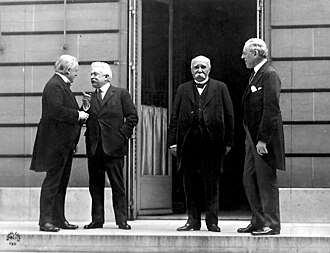Council of Four

The Council of Four , also known as the Big Four , in its initial phase Council of Ten , made the most important decisions after the First World War as part of the Paris Peace Conference of 1919 . It consisted of the four heads of government of the most powerful victorious nations, Georges Clemenceau ( France ), David Lloyd George ( Great Britain ), Vittorio Emanuele Orlando ( Italy ) and Woodrow Wilson ( USA ), who were decisive among the 32 nations present.
Woodrow Wilson presented his 14-point program at the congress , in which he called for the peoples' right to self-determination, which, however, was not accepted in essential points, which is why the USA did not ratify the results of the congress. He also wanted to establish a League of Nations . When the contract was signed, Great Britain had primarily financial interests, while Italy wanted to enlarge its territory and France wanted security from the German Reich and a revenge for the Franco-Prussian War .
At the conference, which began on January 18, 1919, Clemenceau was first appointed President of the conference at the suggestion of Wilson. Since the plenary assembly consisted of over 1000 delegates, a council of ten was initially appointed, consisting of the heads of government and foreign ministers of the nations who were later also on the council of four, as well as two Japanese representatives. Since Japan had little interest in European problems, the decision-making body became the Council of Four on March 24, 1919 , which met a total of 148 times, almost every day.
Individual evidence
- ^ Gerhard Altmann, Arnulf Scriba: Paris Peace Conference. In: Living Museum Online . September 14, 2014, accessed January 9, 2020 .
- ↑ Eberhard Kolb: The Weimar Republic . In: Oldenbourg floor plan of the story . 6th edition. tape 16 . Oldenbourg Wissenschaftsverlag, Munich 2002, ISBN 3-486-49796-0 .